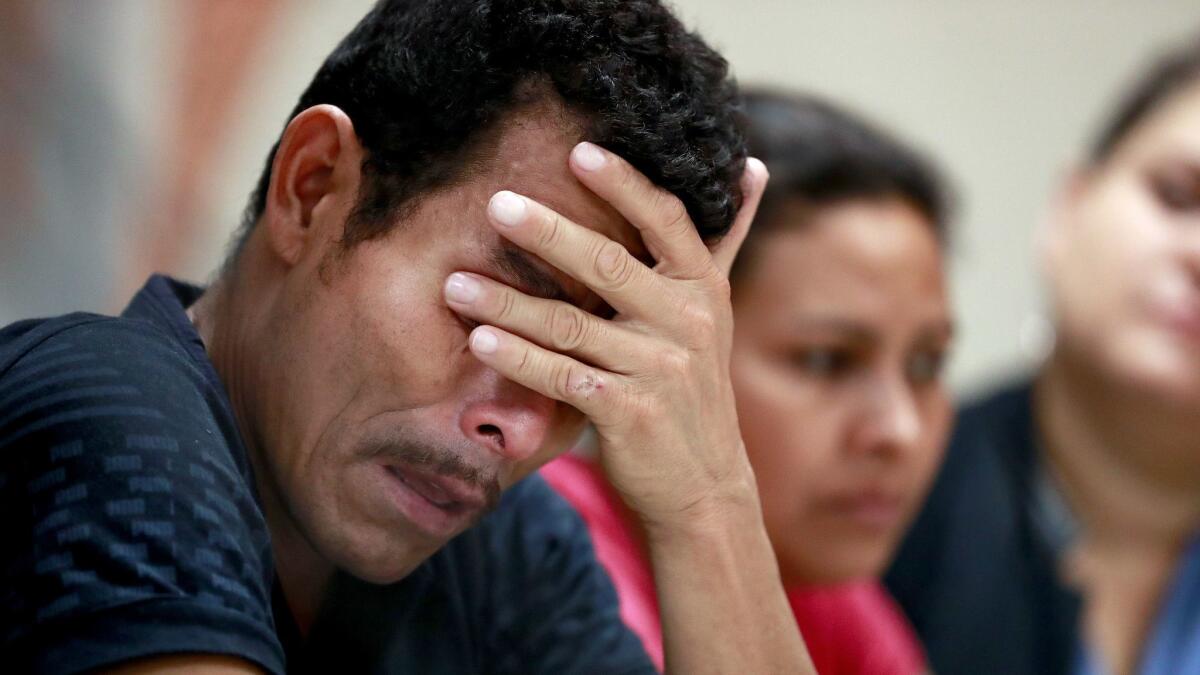Difficult road lies ahead for reuniting migrant children with parents, despite court ruling

A day after a San Diego federal judge issued an injunction ordering the Trump administration to reunite thousands of migrant children with their parents within the next 30 days, the next central question seems to be: Now what?
There was no clear answer Wednesday as various federal agencies struggled with how to abide by the order, especially given the confusion that continues in light of President Trump’s executive order last week to end family separations at the border.
Asked about the injunction, Trump offered no complaint, saying, “We believe the families should be together also, so there’s not a lot to fight.”
But details on a plan of action were scarce.
The Department of Health and Human Services, which is in charge of the separated children, referred questions Wednesday to the Justice Department, which in turn said it was up to Congress to deal with the border situation.
“Without this action by Congress, lawlessness at the border will continue, which will only lead to predictable results — more heroin and fentanyl pushed by Mexican cartels plaguing our communities, a surge in MS-13 gang members, and an increase in the number of human trafficking prosecutions,” a DOJ representative said.
HHS is caring for about 12,000 migrant children, including some 2,000 who arrived at the U.S.-Mexico border with a parent.
The department’s Administration for Children and Families said in a statement that it was “focused on continuing to provide quality services and care” to minors being held in Office of Refugee Resettlement-funded facilities and reunifying children with relatives or appropriate sponsors.
“Reunification is always the ultimate goal of those entrusted with the care of unaccompanied alien children, and we are working toward that for those unaccompanied alien children currently in our custody,” it said.
But Robert Carey, who led the refugee office during the Obama administration, said the agency will probably struggle to link children with their parents, especially if parents are still detained or have already been deported.
Historically, children in the refugee office’s care arrive alone in the U.S., with personal documents or a contact for a relative already in the country, making it easier to place them with a sponsor. But there have been widespread reports of children being taken from their parents unexpectedly, and where neither side knows where the other is.
In his order, U.S. District Judge Dana Sabraw was highly critical of the reunification process, arguing that administration officials were only trying to reunite kids who were being removed from the country. When parents were not immediately removed, it was essentially up to the parent to try to locate a child.
“The facts set forth before the court portray reactive governance — responses to address a chaotic circumstance of the government’s own making,” he wrote.
The ACLU, which requested the injunction as part of a federal lawsuit in San Diego, celebrated Sabraw’s order Wednesday and said it would be closely monitoring the government for compliance.
Here are some of the central questions surrounding family separations and what the injunction means.
What exactly did the injunction do?
The preliminary injunction calls for all immigrants in U.S. Department of Homeland Security custody to be reunited with their separated children within 30 days, or 14 days for youngsters under 5. It also requires parents to have telephone contact with their separated children in government custody within 10 days.
The order prohibits future immigrants in DHS custody from being detained without their children. And if the parent is released, then their children must also be released into their custody. Children must also be deported with their parents.
There are some exceptions: If a parent is found to be unfit or a danger to the child, or if a parent voluntarily declines to be reunited while in DHS custody or for deportation.
Is the injunction just for those who cross the border illegally?
No, families who present themselves at a port of entry with a claim for asylum have also been separated — including a Congolese woman known as Ms. L. in the San Diego lawsuit — so the injunction covers them, as well. These separations usually occur if immigration officials cannot verify the parental relationship with the children or because a parent had some kind of criminal history. It is not yet clear how the judge’s order will affect these cases.
“We are a country of laws, and of compassion,” Sabraw stated in his order regarding asylum seekers. “We have plainly stated our intent to treat refugees with an ordered process, and benevolence, by codifying principles of asylum. The government’s treatment of Ms. L and other similarly situated class members does not meet this standard and it is unlikely to pass constitutional muster.”
Is this timeline for reunification reasonable?
The American Civil Liberties Union , which requested the injunction, thinks so.
“This is more a matter of priority or urgency than an inability to deal with logistics,” ACLU attorney Lee Gelernt said in a conference call with reporters Wednesday. “When the U.S. government puts all its resources to work, it can get something like this done easily.”
He said the ACLU doesn’t care about the specifics of the plan, as long as it gets done. He said thousands of volunteers and nonprofit agencies stand ready to assist the government in getting children back together with their parents.
The government argued in a briefing just a day earlier that a court order would slow down the reunification process and “cause confusion and conflicting obligations.”
There are logistical challenges. Children are being kept in shelters across the United States — many are thousands of miles from the border. Many immigrant parents say they haven’t been able to locate their children because the parents don’t have their “A number,” or “alien number.”
Immigration authorities will have to determine whether to detain families as units — a difficult proposition because of a serious lack of bed space appropriate for families and a court settlement limiting the amount of time children can spend in detention. Authorities could also parole them into the community, possibly under GPS monitoring. The Trump administration has been reluctant to offer parole to immigration detainees, a practice that was used by the Obama administration.
The government is seeking to have family detention quarters set up on military bases, possibly including Camp Pendleton, but it is unknown how soon the facilities would be up and running.
And then there are the unknown number of parents who have already been deported from the U.S. without their children.
Can the government appeal?
The government can request an emergency stay of the injunction — a step it would probably take if it did not want to begin immediately complying with the order — and it can appeal the injunction to the U.S. 9th Circuit Court of Appeals. The 9th Circuit option might be taken if the Trump administration wants to fight the order’s prohibition of family separations.
It is not clear yet what the government will do.
How does the injunction affect criminal immigration prosecutions under the ‘zero-tolerance’ policy?
The injunction does not have a direct effect on criminal prosecutions.
Under its “zero-tolerance” policy, the Trump administration has vowed to criminally prosecute 100% of people caught illegally crossing the border. That means immigrants are arrested and taken to a criminal detention facility.
The injunction does not order parents to be released from criminal detention or for children to be reunited with a parent in the custody of the U.S. Marshals Service. Instead, the order directs reunification once the criminal case is over and the parent is released into DHS custody for civil immigration proceedings.
For those who are charged with misdemeanor illegal entry — the charge that makes up the vast majority of arrests under zero tolerance — the criminal case usually takes a few weeks to a month in the Southern District of California.
To confuse matters, Trump’s executive order on family separation indicates families caught at the border facing criminal entry charges will be detained together in the future.
Since that executive order, the Border Patrol has generally declined to refer parents apprehended with children for criminal prosecution unless the parent has a criminal record or there are extenuating circumstances.
What was the judge’s reasoning for granting the injunction?
Sabraw disagreed with the government’s argument that the executive order settled the family separation issue and thus an injunction was not needed. The executive order did not address reunifying the 2,000-plus children already separated, and it is not absolute in its promise to halt separations.
Sabraw ruled that the way families have been separated “shocks the conscience,” which is a legal standard used when weighing such injunctions, and found that the separations caused irreparable harm to children.
He noted the lack of an effective system or procedure to track separated children, noting that detainees’ personal property is better accounted for than their children are. He concluded that nothing in the injunction would stymie Trump’s ability to enforce criminal and immigration laws.
“The Government would remain free to enforce its criminal and immigration laws, and to exercise its discretion in matters of release and detention consistent with law. It would just have to do so in a way that preserves the class members’ constitutional rights to family association and integrity.”
Davis writes for the San Diego Union-Tribune.
More to Read
Sign up for Essential California
The most important California stories and recommendations in your inbox every morning.
You may occasionally receive promotional content from the Los Angeles Times.










